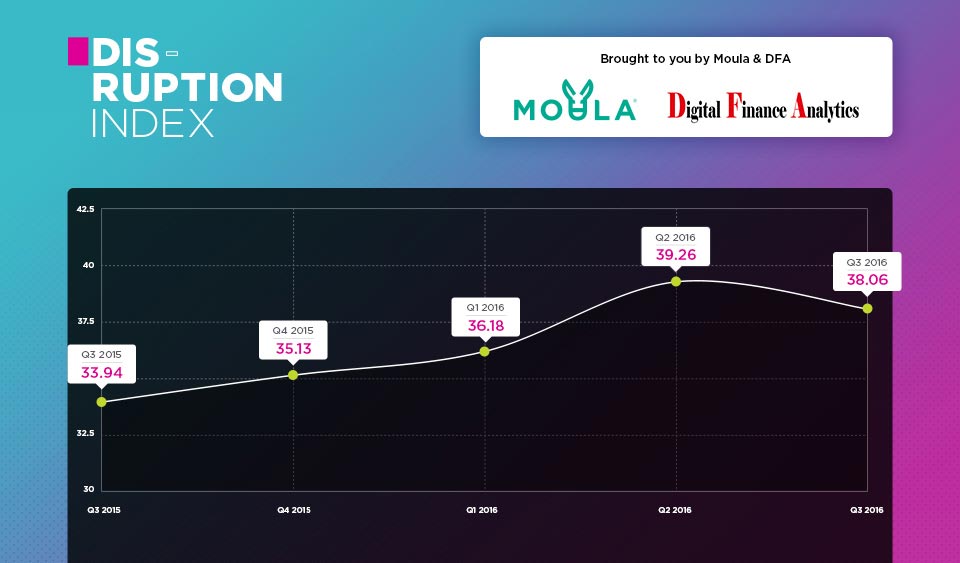The latest edition of the Digital Finance Disruption Index, a joint initiative by Digital Finance Analytics and Moula – a fast and friendly way to give small businesses access to capital – is released today. The Disruption Index tracks change in the small business lending sector, and more generally, across financial services.
 Financial Services are undergoing disruptive change, thanks to customers moving to digital channels, the emergence of new business models, and changing competitive landscapes. Using combined data from the DFA SME Survey, and from Moula on loans processed, we track the momentum of this disruption in Australia.
Financial Services are undergoing disruptive change, thanks to customers moving to digital channels, the emergence of new business models, and changing competitive landscapes. Using combined data from the DFA SME Survey, and from Moula on loans processed, we track the momentum of this disruption in Australia.
This quarter the index slipped a little to 38.06, from 39.26 in the previous quarter, showing the first small decline in the index in the 6 quarters since the index began, but should be read in the context of a significant increase in the previous quarter.
The reasons are mixed, however, we still see the trend moving strongly upward over the long term as all the catalysts of disruption are building : use of electronic devices, use of electronic data and a continuing trend away from bank brand loyalty to those providers who deliver the best products and service.
Looking at some of the highlights:
- Awareness of non-bank funding options continues to grow among SMEs, thanks partly to greater coverage in the media of “Fintech”. However, there is more to be done to link Fintech more directly with unsecured lending in the minds of SME’s.
- Business confidence rose in borrowing SME’s especially in eastern states of NSW, VIC and ACT. Less strong in SA, TAS and QLD. However, this was offset by a strong fall in WA thanks to the end of the mining boom, and second order impacts across other industry sectors there.
- The proportion of SMEs with smart devices has risen – now well over half of all SMEs at 54% are using their smart device as their primary business management tool. Most smart devices are multi-function phones, rather than tablets. Younger business owners have an ever higher penetration rate.
- Coupled with the increasing adoption of smart devices in SMEs, we are also seeing increasing use of cloud accounting data, not only in running a SME but also to obtain a loan (through data permissioning). In the latest results, over half of all businesses permissioned Moula into cloud accounting data.
- The availability of data, and the non-reliance of traditional business plans, has meant that Moula is capable of processing SME loans within a 24 hour period – evidenced by an average approval time of 20 hrs in the most recent quarter.
The Disruption Index is an important tool which will highlight the changing face of financial services in Australia. There is no doubt that new business models are emerging in the context of the digital transformation of the sector, and bank customers are way ahead of where many incumbents are playing. The SME sector in particular is underserviced, and it offers significant opportunity for differentiation and innovation.
In the last three months we have seen a significant shift in attitudes among SMEs as they become more familiar with alternative credit options and migrate to digital channels. The attraction of online application, swift assessment and credit availability for suitable businesses highlights the disruption which is underway. There is demand for new services, and supply from new and emerging players to the SME sector.
Read more on the Disruption Index Site.
